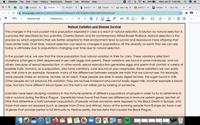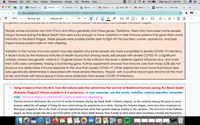
Human Anatomy & Physiology (11th Edition)
11th Edition
ISBN: 9780134580999
Author: Elaine N. Marieb, Katja N. Hoehn
Publisher: PEARSON
expand_more
expand_more
format_list_bulleted
Concept explainers
Question
Using evidence from the text, how can natural selection determine the survival of humans during the current COVID-19 pandemic? Please explain in 2-3 sentences. In your response, use the words:

Transcribed Image Text:Chrome
File
Edit
View
History Bookmarks
Реople Tab
Window
Help
88%
Wed Jan 27 1:44 PM
Evolution X
E TENZINE X
Paraphra x b Search re x
Classwor X
Meet
(MP2) Wi X
DeltaMat X New Tab
+
docs.google.com/document/d/1wlo4ee5fHQWkeyOh-B8FYluBGBAx98BFQ8RDOkPiaX0/edit
* BI
в IUA
▼三、
E E
90%
Normal text
Century Go..
12
+
▼
...
Natural Variation and Disease Survival
The changes in the rock pocket mice population explored in class is a result of natural selection. Evolution by natural selection is
a process first described by two scientists, Charles Darwin and his contem
porary Alfred Russel Wallace. Natural selection is the
process by which organisms that are better adapted to their environment tend to survive and reproduce more offspring that
have similar traits. Over time, natural selection can lead to changes in populations. All the diversity on earth that we can see
today is ultimately due to populations changing over time due to natural selection.
In the pocket mice, we saw that the mice population had natural variation in their fur color. These variations arise from
mutations (changes in DNA sequences) in sex cells (eggs and sperm). These variations are found in some individuals, and not
others, because of sexual reproduction. In other words, sexual reproduction generates eggs and sperm that contain a variety of
possible traits. Humans, as a population, also have variations. Look around at your classmates. Some variations we can easily
see, hair color is an example. However, many of the differences between people are traits that we cannot see. For example,
some people make an enzyme, lactase, as an adult. These people are able to easily digest lactose, the sugar found in milk.
Other people do not produce this variation; they are lactose-intolerant and cannot easily digest milk. Another example is blood
type. Humans have different blood types, but this trait is not visible just by looking at someone.
Scientists have been studying variations in the immune systems of different populations of people in order to try to determine its
role in survival during the Black Plague . Geneticists have found that there are differences in immune system genes (section of
DNA that determine a trait) between populations of people whose ancestors were exposed to the Black Death in Europe, and
those that were not exposed (such as people from China and Africa). Many of the surviving people from Europe do have a set
of genes that provide partial to full immunity to Yersinia pestis, the bacteria that caused the Black Plague.
JAN 9
27
84
...
lil

Transcribed Image Text:Chrome
File
Edit
View
History Bookmarks
Реople
Tab
Window
Help
88%
Wed Jan 27 1:45 PM
Evolution X
E TENZINE X
Paraphra x b Search re x
Classwor X
Meet
(MP2) Wi X
DeltaMat X New Tab
+
docs.google.com/document/d/1wlo4ee5fHQWkey0h-B8FYluBGBAx98BFQ8RDOkPiaX0/edit
B I U A
90%
Normal text
Century Go..
12
+
...
Or geneS IMUT PIOVIUE Pa TIUITO TUIL I||I|||O||y TO TEISIL INU PESTIS, ITTE DUCIENA INUI CAUSEU INE DIUCKFIaguE.
People whose ancestors are from China and Africa generally lack these genes. Therefore, there may have been some people
living in Europe during the Black Death that were lucky enough to have variations in their immune systems that gave them some
immunity to the Black Plague. These people were possibly better able to fight off the bacteria, survive, reproduce, and pass
these immune system traits on their offspring.
Variation in the human immune system may also explain why some people are more susceptible to severe COVID-19 infections.
A recent study by the National Institutes of Health found that among nearly 660 people with severe COVID-19, a significant
number carried rare genetic variants in 13 genes known to be critical in the body's defense against influenza virus, and more
than 3.5% were completely missing a functioning gene. Further experiments showed that immune cells from those 3.5% did not
produce any detectable immune response to the virus that causes COVID-19. Other researchers have found that blood type
(also genetically determined) is associated with more severe infections. People with A positive blood types tend to be the most
at risk, and those with blood group 0 have some protection from severe COVID-19 infections.
1. Using evidence from the text, how did natural selection determine the survival of Medieval humans during the Black Death
(Bubonic Plague)? Please explain in 4-5 sentences. In your response, use the words: variation, natural selection, favorable
traits. This must follow a CER format (claim, evidence, reasoning)
Natural selection determines the survival of medieval humans during the black death ( bubonic plague), as the variation among the genes in some
humans added the advantage of being the best suited among the population as a whole. During this bubonic plague, some mice have mutations in
their gene sequences due to the result of sexual reproduction that alters their genetic makeup leading to the variation. The survivors of this bubonic
plague are those people that have survived earlier with the black death disease from Europe as their genes show resistance towards this bacterium,
JAN 9
27
84
...
lil
Expert Solution
This question has been solved!
Explore an expertly crafted, step-by-step solution for a thorough understanding of key concepts.
This is a popular solution
Trending nowThis is a popular solution!
Step by stepSolved in 2 steps

Knowledge Booster
Learn more about
Need a deep-dive on the concept behind this application? Look no further. Learn more about this topic, biology and related others by exploring similar questions and additional content below.Similar questions
- Mutations are random, thus it is just by chance that a species will adapt fast enough to survive True Falsearrow_forwardHi, I am quite confused by the microbiome Whole-genome Wide Association Study. What are the differences between Quantitative Trait Loci and Microbiome Trait Loci? Are they represent the location of SNPs itself?arrow_forwardAre humans still evolving as species? Please think about the story of human evolution uncovered through genetic studies, and possible evidence that the evolution of our species continues. (essay type preferably 1100 words or more if possible..used as basis for academic research)arrow_forward
- Red numbers are bootstrap scores. Recall that any bootstrap score >= 90% is considered strong. From image attached answer the following: Are most bootstrap scores in your tree >= 90%? Does your tree support the hypothesis that HIV-1 is closely related to chimpanzee SIV (SIV_CPZ)? Does your tree support the hypothesis that HIV-2 is closely related to various non-chimpanzee SIVs?arrow_forwardHelp (43)arrow_forwardIf 9% of an African population is born with a severe form of sickle-cell anemia (ss), what percentage of the population will be more resistant to malaria because they are heterozygous (Ss) for the sickle-cell gene? Assume Hardy-Weinberg conditions. Submit your answer as it is. a) homozygous recessive individuals (q²) b) the recessive allele (q) c) the dominant allele (p) d) homozygous dominant individuals (p²) e) heterozygous individuals (2pq)arrow_forward
- Enlarge Image 100 Mutation causes variation Conditions do not favor some mutations Survivors reproduce Change in conditions do not favor some traits Survivors reproduce 1) This model shows the process of natural selection on rabbits demonstrating variation in fur color over several generations. Using the model, what most likely led to the loss of white furred rabbits in the population? A) XB) C) The white rabbits did not reproduce fast enough to survive. White was a recessive trait and therefore not passed on to any offspring. The white fur was a favorable trait but was never prevalent in the population. The rabbits with white fur had less camouflage in D) the environment and were more easily preyed on by predators. 2) If this model continues, with no major changes to the environment, what do you expect to happen? XA) Rabbits will continue to get lighter over time.arrow_forwardHuman Skin Color: Evidence for Selection Name: Jayden Bodisto Make observations of the Figure below. Then complete the portion below. Erythemal UV index 80 0 09- KNMI/ESA -120 0 -120 2 4 -60 6 8 10 60 Clear-sky 24 September 2015 120 10 60 12 14 120 16 -60 18 Figure 1. Ultraviolet Radiation Index Across the World. The colors on this map of the world represent Ultraviolet (UV) Index values on a particular day in September 2015. The UV Index is a standardized scale of UV radiation intensity running from 0 (least intense) to 18 (most intense). The y-axis values are degrees of latitude, which range from the equator (0°) to the poles (90° north and -90° south). The x-axis values are degrees of longitude, which range from the prime meridian (0°) to the antimeridian (180° east and -180° west). (Source: European Space Agency, http://www.temis.nl/uvradiation/UVindex.html.) The Driving Question: What is the relationship between UV radiation and skin color? What do I see? List specific things you…arrow_forward
arrow_back_ios
arrow_forward_ios
Recommended textbooks for you
 Human Anatomy & Physiology (11th Edition)BiologyISBN:9780134580999Author:Elaine N. Marieb, Katja N. HoehnPublisher:PEARSON
Human Anatomy & Physiology (11th Edition)BiologyISBN:9780134580999Author:Elaine N. Marieb, Katja N. HoehnPublisher:PEARSON Biology 2eBiologyISBN:9781947172517Author:Matthew Douglas, Jung Choi, Mary Ann ClarkPublisher:OpenStax
Biology 2eBiologyISBN:9781947172517Author:Matthew Douglas, Jung Choi, Mary Ann ClarkPublisher:OpenStax Anatomy & PhysiologyBiologyISBN:9781259398629Author:McKinley, Michael P., O'loughlin, Valerie Dean, Bidle, Theresa StouterPublisher:Mcgraw Hill Education,
Anatomy & PhysiologyBiologyISBN:9781259398629Author:McKinley, Michael P., O'loughlin, Valerie Dean, Bidle, Theresa StouterPublisher:Mcgraw Hill Education, Molecular Biology of the Cell (Sixth Edition)BiologyISBN:9780815344322Author:Bruce Alberts, Alexander D. Johnson, Julian Lewis, David Morgan, Martin Raff, Keith Roberts, Peter WalterPublisher:W. W. Norton & Company
Molecular Biology of the Cell (Sixth Edition)BiologyISBN:9780815344322Author:Bruce Alberts, Alexander D. Johnson, Julian Lewis, David Morgan, Martin Raff, Keith Roberts, Peter WalterPublisher:W. W. Norton & Company Laboratory Manual For Human Anatomy & PhysiologyBiologyISBN:9781260159363Author:Martin, Terry R., Prentice-craver, CynthiaPublisher:McGraw-Hill Publishing Co.
Laboratory Manual For Human Anatomy & PhysiologyBiologyISBN:9781260159363Author:Martin, Terry R., Prentice-craver, CynthiaPublisher:McGraw-Hill Publishing Co. Inquiry Into Life (16th Edition)BiologyISBN:9781260231700Author:Sylvia S. Mader, Michael WindelspechtPublisher:McGraw Hill Education
Inquiry Into Life (16th Edition)BiologyISBN:9781260231700Author:Sylvia S. Mader, Michael WindelspechtPublisher:McGraw Hill Education

Human Anatomy & Physiology (11th Edition)
Biology
ISBN:9780134580999
Author:Elaine N. Marieb, Katja N. Hoehn
Publisher:PEARSON

Biology 2e
Biology
ISBN:9781947172517
Author:Matthew Douglas, Jung Choi, Mary Ann Clark
Publisher:OpenStax

Anatomy & Physiology
Biology
ISBN:9781259398629
Author:McKinley, Michael P., O'loughlin, Valerie Dean, Bidle, Theresa Stouter
Publisher:Mcgraw Hill Education,

Molecular Biology of the Cell (Sixth Edition)
Biology
ISBN:9780815344322
Author:Bruce Alberts, Alexander D. Johnson, Julian Lewis, David Morgan, Martin Raff, Keith Roberts, Peter Walter
Publisher:W. W. Norton & Company

Laboratory Manual For Human Anatomy & Physiology
Biology
ISBN:9781260159363
Author:Martin, Terry R., Prentice-craver, Cynthia
Publisher:McGraw-Hill Publishing Co.

Inquiry Into Life (16th Edition)
Biology
ISBN:9781260231700
Author:Sylvia S. Mader, Michael Windelspecht
Publisher:McGraw Hill Education